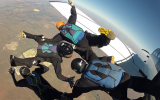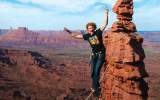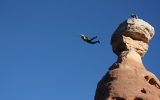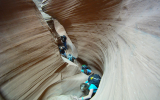- Magazine
- #readityourway
- Weekly Stories
- #shareyourstory
-
Adventure
- Abroad Travelling
- Africa Travelling
- Events
- Expos & Shows
- Festivals
- Fishing
- Free Diving
- Gliding
- Horse Riding
- Inspiring People
- Islands Travelling
- Kite/Windsurfing
- Motorbiking
- Motorised Water Sports
- Mountaineering
- Mountain Biking
- Off-road 4x4
- Off-road Motorbiking
- Paddling
- Performance Driving
- Photography
- Rock Climbing
- Rollerblading
- Sailing
- Scuba Diving
- Skateboarding
- Skydiving
- Snowboarding & Skiing
- Surfing
- Swimming
- Trail Running
- Wakeboarding
- Waveski Surfing
-
Sport
- Adventure Racing
- Fishing
- Free Diving
- Gliding
- Health & Fitness
- Horse Riding
- Inspiring People
- Kite/Windsurfing
- MMA
- Motorbiking
- Mountain Biking
- Multi-sport
- Off-road 4x4
- Off-road Motorbiking
- Paddling
- Performance Driving
- Photography
- Road Cycling
- Road Running
- Rock Climbing
- Rollerblading
- Sailing
- Scuba Diving
- Skateboarding
- Skydiving
- Snowboarding & Skiing
- Surfing
- Swimming
- Rugby
- Trail Running
- Triathlon
- Wakeboarding
- Waveski Surfing
- Lifestyle
- Calendar
Jumping into Paradise
Words: Amy Shaw | Photos: Bryan Rapoza www.avenfoto.com & Sica De St Jeor | Video: Aki Papakyprianou
Topic:
Skydiving
Into the ocean ye sail, past Captain Hook’s secret bay of sirens and the mystical Blue Caves to a cove of smugglers what cannot be found except by those who already knows where it is. Guarded by towering cliffs of sandstone and envied by onlookers who can see its tantalising beauty from afar yet not but stand at the dizzying precipice and gape with the awe and desire of a thousand booty seekers. Here lies the shipwreck and its unimaginable treasures.
That's quite a voyage, right sailor? Well, there is one other way into this infamous cove. If you’re a BASE jumper you don't need to worry about commandeering that treasure map from Captain Blackeye. Rather buckle up your parachute and enter this secret cove the fast way, which is by freefall!
And so it was in August 2012 that a band of unruly misfits descended (quite literally) on Navagio (meaning shipwreck) Beach, on Zakynthos Island, in Greece. Nestled in a secluded bay surrounded by sandstone cliffs, this beach has earned itself a number of nicknames; that of the Shipwreck Beach, The Navagio, or Smugglers Cove. As the tale goes, sometime in 1981 Greek Navy ships were tipped off that the Patagiotis, a freightliner, was in the waters around Zakynthos Island and smuggling contraband, including cigarettes, wine and white meat (women). Pursuit was initiated, but stormy weather made for difficult navigation and bad visibility, resulting in the alleged smugglers running aground on Navagio Beach. The ship was abandoned and still rests buried in the beach's white sand.
Due to the 200 m sheer limestone cliffs protecting Smugglers Cove it is usually only accessible by boat, with daily tours bringing in tourists from nearby Porto Vromi and Port Nicholas to lounge on this small and isolated, yet strikingly beautiful sandy cove that is defined by white sand beaches and clear blue water. But for one week during August, I was lucky enough to be part of a group of 37 experienced BASE jumpers from around the world who were invited by Go Fast Energy to celebrate life by leaping from the rocks surrounding the cove and free-falling for up to six seconds before deploying our parachutes to land safely on the beach in front of enthralled onlookers. The occasion was the 2012 Go Fast BASE Jump Invitational.
Local boat operators came onboard for the event, providing one-way transport out of the cove for jumpers to repack our parachutes after each jump, before heading back up to the top for more!
The cliffs around the bay that we were jumping from are what jumpers call 'sub terminal' because their relatively-low height dictates a short free-fall that doesn’t allow jumpers to accelerate to terminal velocity before deploying their parachutes.
On bigger jumps, when jumpers start to reach terminal velocity, the high airspeed gives them a certain amount of aerodynamic control to 'fly' away from the cliff, like a glider, and open their parachute a safer distance from the obstacle. However, the trajectory of a lower jump like this is based entirely on momentum, like a high board diver, so one must utilise experience and a keen spacial awareness to exit the rock in such a way as to reach the desired body position at the time of deployment, and ensure a safe extraction of the parachute (referred to as a 'canopy'). Canopy extraction when one is upside down is considered a bad thing for one’s health.
The packing method of the canopy is modified depending on the height of the object jumped from. In this case we packed them so that they would open very quickly and accurately away from the rock. Strict event safety precautions were part of the package agreed upon with the local Greek authorities, and the Go Fast team had ropes and rescuers on hand to rappel down should anything go wrong. Of the more than 350 jumps made over the course of the week, only one incident occurred whereby a jumper's parachute opened in line-twists, which prevented him from steering away from the rock and he became ensnared approximately 12 metres above the ground. The rescue team stepped up to the occasion in magnificent style and had him safely off the wall in no time, and jumping resumed within 15 minutes; proving that there is a responsible way to practise adrenaline sports.
The motley crew of eccentric jumpers were all housed together in the nearby Blue Beach Hotel, which provided warm hospitality to the mischievous bunch. Thankfully Greece has an open mind towards public nudity, spearguns in the swimming pool, and large-scale aerosol fires, because a group of adrenalin enthusiasts certainly do!
As a nomadic BASE jumper, I have spent the better part of the last two years chasing mountains across the interior parts of the world in search of the best jumping sites. But the unique combination of a relaxing seaside paradise and adrenalin-fuelled BASE jumping truly made me feel as if I had stepped onto the shores of Never-Never Land.
In-between jumps, the glittering blue waters of the Mediterranean and the island's famous 'Blue Caves' provided hours of snorkelling and scuba diving amongst the exquisite sandstone caves, many of which are entirely submerged. Free diving through underwater entrances to emerge in twinkling caverns, one might be forgiven for believing they had stumbled across the hiding place of stolen pirate treasure, or the lair of mythical sirens. Indeed, as the week came to a close, I would have happily been lured by such a mythical creature to remain in this Never-Never Land forever.
BASE jumping is many things to many people; a dare-devil stunt, YouTube sensation-seeking or an intense experience of self-mastery. It is a congregation of people from every walk of life; doctors and oil riggers coming together in a diverse travelling community that is unified by a common appreciation for life in all its intensity.
Some people look at us and wonder why we do it. Perhaps to them we are the lost boys of Never-Never Land. But as I look around the paradise this lifestyle has led me to - good food, warm breezes and even warmer people - I can't help but wonder, with no shortage of happy thoughts, how can one do anything but fly?
dinFO:
Get into BASE jumping
BASE jumping is an extremely dangerous sport and thus there is no fast way to learn. For safety reasons, one must first be an experienced skydiver before attempting to BASE jump. Visit www.para.co.za for listings of various drop zones around SA. They will train you through the various stages to obtain your skydiving licence. Once licensed, you need to obtain a minimum of 200-500 skydives and reach a competent skill level, particularly in canopy control. When you are ready, find a mentor, who is an experienced BASE jumper, to guide you through the learning stages of the sport.
First BASE jumps are usually done off safer objects like bridges, before progressing to more challenging objects like antennas, buildings and cliffs. Progression is an ongoing process of many years and, due to the high risk nature of BASE, requires total commitment to every stage of the journey.
Tips for safe BASE jumping
• Know your own limits.
• Do not be influenced by the decisions of others.
• And be patient, the way to becoming the best BASE jumper is to live the longest!
More on BASE jumping
For more information on BASE jumping, have a look at the following sites:
www.chickonthewing.wordpress.com,
www.apexbase.com, www.basedreams.com,
and www.gofastsports.com
BASE jumper’s forum Visit www.basejumper.com
Issue:
Issue 20 Dec '12
Contributor:
Amy Shaw











